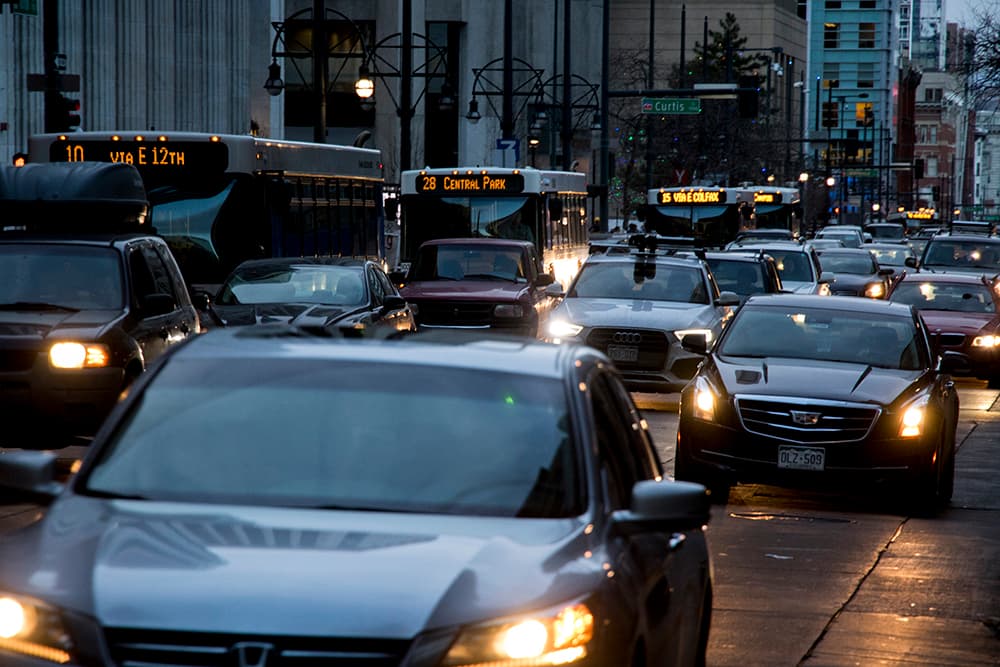Part of the Denver's vision for the year 2040, when it projects a population of somewhere around 900,000 people, is a fuller embrace of public transit — by the city, but also by its residents.
"One of the biggest steps is more philosophical than actual," said Denver City Councilwoman Mary Beth Susman. "We need to own the problem. Denver has to own its own problem of transit around the city."
She has advocated for the city to take transit into its own hands by creating a transit department.
"RTD is a regional operation, and it is answering to its regional requirements, especially with light rail, of course — and their ability to concentrate on the particular needs of a city our size, I just don’t think it’s there."
Eulois Cleckley, the new head of the Department Public Works, said when the plan was released that the goal is to help Denverites get around “without having to rely on their vehicles.”
“There’s going to be a higher demand on alternative transportation modes, and transit is truly the great equalizer,” he said in an interview.
"We have to try to get it even more convenient than cars," Susman said. "And I don’t know that we have the density yet to make transit more convenient than cars."
Denverite's Ashley Dean reported earlier this year that while the city is growing toward being a round-the-clock metropolis, transit is part of a chicken-and-egg obstacle between here and there.
The Denver Moves plan (PDF) envisions, among other things, extended and more frequent service along major thoroughfares, including high-capacity corridors like Broadway, Colfax and Park Avenues, Speer, Federal and Colorado Boulevards, and other highlighted corridors like M.L.K. Jr. and Sheridan Boulevards, Sixth, Eighth and 38th Avenues to name a few.
Some of the most drastic changes would be in that second group.
These are major streets that already have transit, but not with the frequency of your Broadways and Colfaxes. Among corridors the plan identifies as "medium-capacity" and "speed and reliability," the city's plan calls for weekday service frequency of every 10-15 minutes during peak hours, and every 15 minutes until 10 p.m.
Take Quebec Street, for example. According to the Denver Moves documentation, buses there run every 25 minutes during peak commute time morning and afternoon, every half hour between, and after 6 p.m., the frequency drops off to every 55 minutes. The plan calls for transit every 15 minutes from 6 a.m. through 10 p.m., and every half hour for some time after that.
The way RTD currently operates, a bus route needs to have a certain amount of ridership per hour before it gets upgraded to the next tier of frequency.
"With all the constraints that we have, with vehicles and operators and budget, we really look for the numbers to be there before we increase service," said Doug Monroe, RTD's manager of corridor planning.
Right now, there aren't enough people boarding buses after 6 p.m. on, say, Sheridan, Hampden or Quebec, to elevate them to the every-15-minutes frequency. But if buses along those areas were more frequent, would more people ride?
"Increased frequency would bring increased ridership," Monroe said. "It's not a one-to-one relationship, so doubling the frequency doesn't double the ridership."
He cited the Flatiron Flyer bus service between Denver and Boulder as an example of a route where RTD added service and saw increased ridership.
"We got the faster travel times with the bus lanes up there on U.S. 36 and boosted service at the same time by about 10 to 15 percent, and we saw a pretty big uptick in ridership around the time that it went into effect," he said.
RTD has talked to the city about ways to move toward that increased service, but there are obstacles.
"What we've talked about is service buy-up, which we've done with Boulder," he said. In Boulder's case, the city wanted more service than what matched their ridership numbers, so they paid RTD to add service. But right now, with a shortage of bus operators, Monroe says it's not only unlikely that buy-ups won't be an option for Denver, but also that they may be off the table for Boulder, where the Dash and the Jump have been bought-up for 15 to 20 years.
For now, RTD is looking at "trying to make the existing network move better," he says. "The city had some bond money for West Colfax, we have a little bit of money for Federal Boulevard over there."
The short-term strategies include looking at giving buses slightly longer green lights and putting "bus bulbs" on curbs, which extend the sidewalk out to where a bus would pull up in traffic, so that it doesn't have to pull out of traffic and then get delayed trying to get back in.
And Monroe says that while RTD was skeptical of a few details, as a resident of Denver, he's excited.
"I'd love to see it succeed," he said.
For the longer-term goals, the city may not be able to rely solely on RTD.
One way or another, the city will have to come up with some money, or a partner — and some drivers. Like Boulder, Denver has considered layering additional services on top of RTD service to achieve its goals, perhaps through its own transportation department, and perhaps through private partnerships.
"When I had sort of imagined a city transit office that I wrote the paper about to the mayor, I thought that we would partner with for-profit companies — because they have the venture capital and can put up the riders and the routes for us," she said. "As a government, we’d never have venture capital to try this out."
Susman thinks that buses in some form, maybe driverless, will be part of the solution because they're flexible and because Denver didn't grow up around rail. She also said Denver needs “ABC” lanes — anything but cars — and that the city's lack of preparedness for dockless scooters underscores the need for a dedicated city transportation department.
"We’re going to have to pull up our big-girl britches and say, 'We have to take ownership of the problem,' and say, 'How is the city going to do this?'"
Denverite reporter Andrew Kenney contributed reporting.














